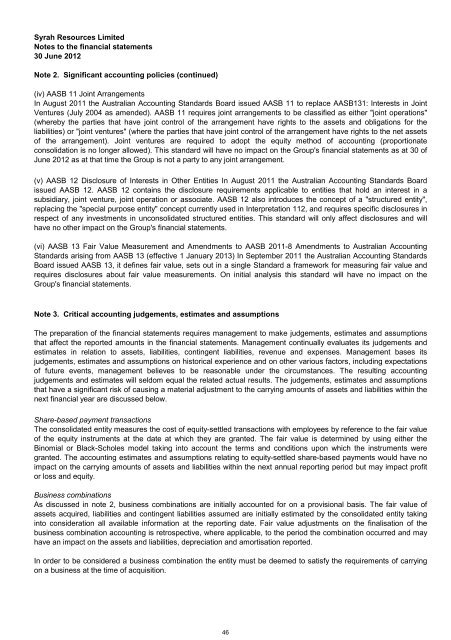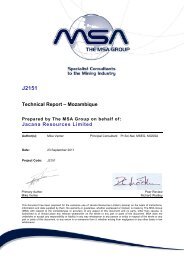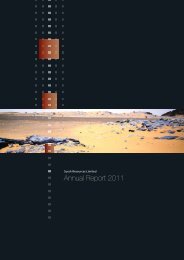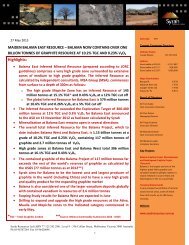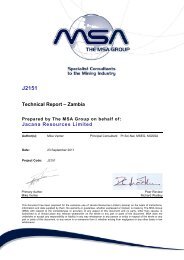Annual Report 2012 - Syrah Resources Ltd
Annual Report 2012 - Syrah Resources Ltd
Annual Report 2012 - Syrah Resources Ltd
Create successful ePaper yourself
Turn your PDF publications into a flip-book with our unique Google optimized e-Paper software.
<strong>Syrah</strong> <strong>Resources</strong> Limited<br />
Notes to the financial statements<br />
30 June <strong>2012</strong><br />
Note 2. Significant accounting policies (continued)<br />
(iv) AASB 11 Joint Arrangements<br />
In August 2011 the Australian Accounting Standards Board issued AASB 11 to replace AASB131: Interests in Joint<br />
Ventures (July 2004 as amended). AASB 11 requires joint arrangements to be classified as either "joint operations"<br />
(whereby the parties that have joint control of the arrangement have rights to the assets and obligations for the<br />
liabilities) or "joint ventures" (where the parties that have joint control of the arrangement have rights to the net assets<br />
of the arrangement). Joint ventures are required to adopt the equity method of accounting (proportionate<br />
consolidation is no longer allowed). This standard will have no impact on the Group's financial statements as at 30 of<br />
June <strong>2012</strong> as at that time the Group is not a party to any joint arrangement.<br />
(v) AASB 12 Disclosure of Interests in Other Entities In August 2011 the Australian Accounting Standards Board<br />
issued AASB 12. AASB 12 contains the disclosure requirements applicable to entities that hold an interest in a<br />
subsidiary, joint venture, joint operation or associate. AASB 12 also introduces the concept of a "structured entity",<br />
replacing the "special purpose entity" concept currently used in Interpretation 112, and requires specific disclosures in<br />
respect of any investments in unconsolidated structured entities. This standard will only affect disclosures and will<br />
have no other impact on the Group's financial statements.<br />
(vi) AASB 13 Fair Value Measurement and Amendments to AASB 2011-8 Amendments to Australian Accounting<br />
Standards arising from AASB 13 (effective 1 January 2013) In September 2011 the Australian Accounting Standards<br />
Board issued AASB 13, it defines fair value, sets out in a single Standard a framework for measuring fair value and<br />
requires disclosures about fair value measurements. On initial analysis this standard will have no impact on the<br />
Group's financial statements.<br />
Note 3. Critical accounting judgements, estimates and assumptions<br />
The preparation of the financial statements requires management to make judgements, estimates and assumptions<br />
that affect the reported amounts in the financial statements. Management continually evaluates its judgements and<br />
estimates in relation to assets, liabilities, contingent liabilities, revenue and expenses. Management bases its<br />
judgements, estimates and assumptions on historical experience and on other various factors, including expectations<br />
of future events, management believes to be reasonable under the circumstances. The resulting accounting<br />
judgements and estimates will seldom equal the related actual results. The judgements, estimates and assumptions<br />
that have a significant risk of causing a material adjustment to the carrying amounts of assets and liabilities within the<br />
next financial year are discussed below.<br />
Share-based payment transactions<br />
The consolidated entity measures the cost of equity-settled transactions with employees by reference to the fair value<br />
of the equity instruments at the date at which they are granted. The fair value is determined by using either the<br />
Binomial or Black-Scholes model taking into account the terms and conditions upon which the instruments were<br />
granted. The accounting estimates and assumptions relating to equity-settled share-based payments would have no<br />
impact on the carrying amounts of assets and liabilities within the next annual reporting period but may impact profit<br />
or loss and equity.<br />
Business combinations<br />
As discussed in note 2, business combinations are initially accounted for on a provisional basis. The fair value of<br />
assets acquired, liabilities and contingent liabilities assumed are initially estimated by the consolidated entity taking<br />
into consideration all available information at the reporting date. Fair value adjustments on the finalisation of the<br />
business combination accounting is retrospective, where applicable, to the period the combination occurred and may<br />
have an impact on the assets and liabilities, depreciation and amortisation reported.<br />
In order to be considered a business combination the entity must be deemed to satisfy the requirements of carrying<br />
on a business at the time of acquisition.<br />
46


